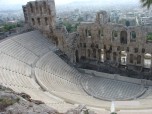In the contemporary world, Anafiotika is as rustic as it gets. Situated on the northeast slope of the Acropolis hill, this small neighborhood is one of the most ideal places to get acquainted with the ancient Greek lifestyle. Despite being overrun by summer tourism activities, this historic section still radiates with classic beauty and serenity.
History
Independent Greece had labeled Athens as the new capital and the then ruler, King Otto I, sought to transform the city into an economic metropolis. As such, there was a subsequent influx of immigrants and construction workers mostly from the Cyclades Islands. These carpenters, sculptors, stone craftsmen and marble cutters used the architectural background they were familiar with to create new homes.
The disadvantages of a low budget and little time led these builders to construct small, simple but functional abodes with narrow meandering alleys and step streets on the uneven terrain. Two churches, the Agios Georgios and the Agios Simeon, were later built to mark the south and north borders, respectively. The distinctive structural design and the history behind this small locality is what now makes Anafiotika a protected archaeological location.
The Design
The picture-perfect whitewashed households, narrow windy streets, colorful bougainvillea blooms, and arrays of vibrantly colored pots on terraces are what make Anafiotika beautiful. The overall fascia is a modest warren of a typical antiquated village. The neighborhood is generally quiet with little activity. A few renovations have been necessary, but the overall beauty and simplicity remains remarkable. Anafiotika forms an idyllic destination and the perfect opportunity to lose yourself in the beauty and splendor of this timeless pocket of ancient Greece.





















